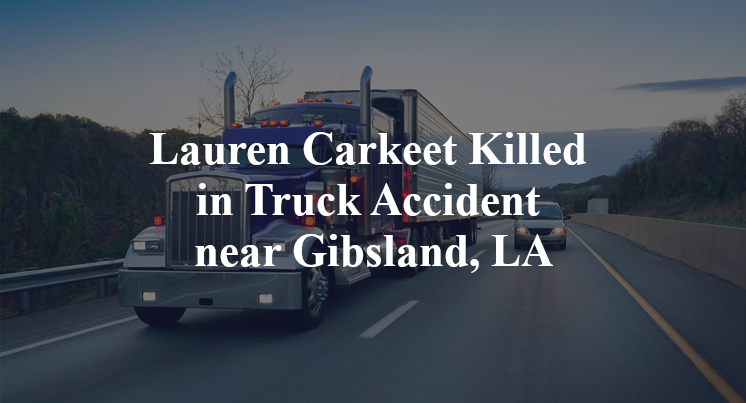Lauren Carkeet Killed in Truck Accident near Gibsland, LA
Bienville Parish, LA — June 15, 2025, Lauren Carkeet was killed in a truck accident at about 5 p.m. on westbound Interstate 20 near Gibsland.
Authorities said a 2010 GMC Acadia crashed into the back of a parked semi-truck near State Highway 154.

GMC passenger Lauren Carkeet, 32, of Lewisville, TX, died at the scene of the crash, according to authorities, while driver Joshua Ware, 29, of Prosper, TX, suffered minor injuries.
The truck driver was not injured in the crash, authorities said.
Authorities have not released any additional information about the Bienville Parish crash at this time. The accident is still being investigated.
Commentary
When someone hears that a car hit the back of a parked semi-truck, the knee-jerk reaction is often to assume it's just a case of a driver not paying attention. But in my experience investigating serious truck crashes, that assumption often doesn’t hold up under scrutiny. In fact, one of the most important things to figure out in cases like this is why the truck was parked there in the first place.
Was it disabled and pulled over temporarily? Was the driver stopped for a break or sleeping in a no-parking zone? Depending on where exactly the truck was parked — on the shoulder, partially in a lane or even just too close to the road — different legal responsibilities come into play. Unfortunately, based on the limited information available right now, we just don’t know those key facts. And that leaves a big unanswered question: Was the truck parked legally and safely, or not?
We’re told the semi-truck was “parked,” but what does that actually mean? Parked how? Parked where? The difference between a truck safely stopped on the shoulder and one carelessly left hanging into a travel lane could be the difference between no fault and clear negligence.
Another thing to look at is lighting and visibility. If this happened around 5 p.m., depending on the weather and terrain, visibility could still be an issue, especially if the truck had no hazard lights, missing reflective tape or wasn't properly marked. It's surprisingly common in my line of work to see trucks that are supposedly “parked” but essentially invisible to oncoming traffic.
That brings us to the technology that can help clarify what happened. The truck's engine control module (ECM) might show whether it was truly stationary or slowly moving. In-cab cameras, if they were installed, could show the driver's behavior in the moments before the crash. And if the trucker claims to have pulled over due to mechanical problems, there ought to be some maintenance records or electronic logs to back that up.
The truck driver wasn’t hurt in the crash, but the question isn’t just whether he was physically affected; it’s whether his actions (or inactions) played a role in someone else's death. Did the trucking company allow, or even encourage, drivers to stop in unsafe areas to meet delivery schedules? Was the driver properly trained on where and how to safely pull off the road? Did the company’s safety protocols clearly prohibit unsafe parking?
I’ve seen firsthand how some companies will point fingers at individual drivers, claiming they acted on their own, when the real story is that company policies and poor oversight helped set the stage for disaster. Getting to the bottom of that takes a lot more than reading a crash report. It takes subpoenas, expert analysis, and sometimes courtroom pressure.
Key Takeaways:
- It's not clear why the truck was parked or exactly where, and those details are crucial to understanding who may be responsible.
- ECM data, in-cab cameras and cell phone records could reveal whether the truck was safely and lawfully stopped.
- Lighting, reflectors and other visibility measures must be examined to see if the parked truck was avoidable.
- The trucking company’s policies and training play a key role in determining whether this was just a fluke or something preventable.
- Real accountability in a crash like this only comes after a full investigation that looks beyond the surface.

“These are essential reads for anyone dealing with the aftermath of a truck wreck”– Attorney Cory Carlson